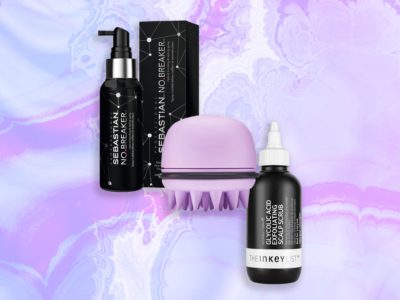
AHAs are water-soluble and work mostly on the skin’s surface, making them a good option for treating fine lines, texture, and dullness. “Alpha hydroxy acids are probably the most common acids that are used for the skin,” explains Geraghty. “Those are really nice for exfoliating that outer layer of skin, leaving the skin brighter, evening out skin tone and texture, and they can even stimulate a little collagen production.”
BHAs, on the other hand, can penetrate deeply into clogged pores and are therefore helpful in treating and preventing acne. “Beta hydroxy acids actually bind to sebum — that’s oil,” says Geraghty. So when those dead skin cells are swept away by a BHA, pore-clogging oil goes with them.
Within these two categories — AHAs and BHAs — are different acids with various skin benefits. Since choosing the best acid for your skin can be confusing, we broke down the most popular options for you.
The Best AHAs
Glycolic Acid
Glycolic acid — which is derived from sugar — is one of the most common acids used in skincare. It has the smallest molecule of all the acids, so it penetrates the deepest, making it one of the most effective acids available. It regenerates collagen, thickens the skin, and evens out the skin tone. But there’s a catch to its dramatic results — since it penetrates so deeply and results in a more intense exfoliation, it also has a higher chance of producing irritation.
Lactic Acid
Lactic acid is the second smallest molecule out of all the acids. It’s gentler than glycolic and draws moisture to the skin, making it a hydrating agent, too. Created from sugar or fermented milk, this alpha hydroxy acid is gentle enough for people with sensitive skin.
Fun fact: Cleopatra was an early AHA adopter and took regular milk baths to improve her skin. “In ancient Egypt, women realized that the lactic acid found in milk had a softening, moisturizing effect on the skin,” explains Geraghty. Today, thousands of years later, “I find that a lot of people with rough, dry or flaky skin [still] rely on products [with lactic acid],” she adds.
Fruit Acids
Even gentler yet are fruit acids such as citric (which is typically derived from lemon or grapefruit) and malic (which usually comes from apples). These larger compounds work on the uppermost layer of the skin, and are often combined with glycolic or lactic acids to help boost their effectiveness.
The Best BHA
Salicylic Acid
If you’ve ever bought an over-the-counter acne treatment, you’re probably familiar with salicylic acid — it’s one of the most popular ingredients for minimizing breakouts. That’s because salicylic acid penetrates and dissolves the oil that clogs pores while also exfoliating away dead skin cells. Even better, it works without irritating already inflamed skin, since it has anti-inflammatory properties.
But Wait… What’s Hyaluronic Acid?
It’s technically an acid because its pH is lower than neutral, but hyaluronic acid is really a humectant best known for its moisturizing properties. This sugar molecule is able to absorb up to 1,000 times its own weight in water and helps trap moisture against the skin’s surface. This kind of water retention allows plumping of the tissue and prevents moisture from escaping the skin, which can help soften the appearance of wrinkles.
How to Use Skin-Care Acids
What are the different ways to incorporate an acid into your skin-care routine?





